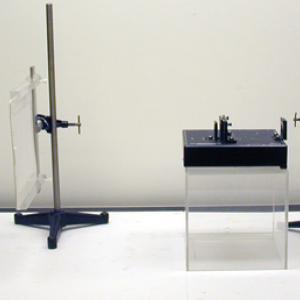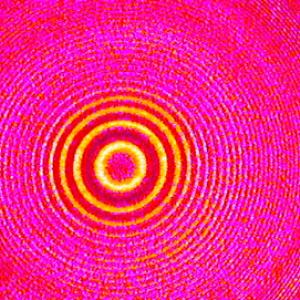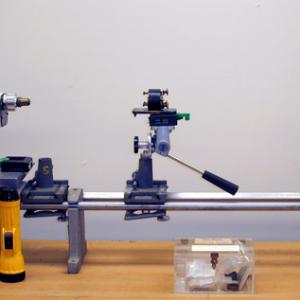College of Liberal Arts & Sciences
6D40.55 - Fabry - Perot Interferometry
The Fabry - Perot unit is delicate in several areas. FIRST, the partially silvered mirrors are very delicate so be very careful when adjusting and cleaning. SECOND, the adjustment used to align the mirrors is very sensitive, BE GENTLE!! In other words the unit should be handled with the utmost care. When the partially silvered mirrors are perfectly parallel you will get a very nice circular interference pattern. This is due to the reflecting of some of the laser light between the two mirrors.
- Jamie A. Boyd, Thierry Lahaye, "A Basic Introduction to Ultrastable Optical Cavities for Laser Stabilization", AJP, Vol. 92, #1, Jan. 2024, p. 50.
- Colin D. Fletcher, Chad Orzel, "Construction and Calibration of a Low Cost Fabry-Perot Interferometer for Spectroscopy Experiments", AJP, Vol. 73, # 12, Dec. 2005, p. 1135.
- T. T. Grove, "A Low-Cost Scanning Fabry-Perot Cavity for Laser Experiments", AJP, Vol. 71, # 2, Feb. 2003, p. 184.
- Joseph F. Mulligan, "Who were Fabry and Perot?", AJP, Vol. 66, #9, Sep. 1998, p. 797.
- Benjamin S. Perkalskis and J. Reuben Freeman, "Fabry-Perot Interferometers for Lecture Demonstrations and Laboratories", AJP, Vol. 64, #9, Sep. 1996, p. 1210.
- R. A. Boyd, J. L. Bliss, K. G. Libbrecht, "Teaching Physics with 670 nm Diode Lasers - Experiments with Fabry - Perot Cavities", AJP, Vol. 9, Sept. 1996, p. 1109.
- Joseph C. Amato, Roger E. Williams, and Hugh Helm, "An Inexpensive, Easy to Build Fabry-Perot Interferometer and its Use in the Introductory Laboratory", AJP, Vol. 59, #11, Nov. 1991, p. 992.
- Chandrasekhar Roychoudhuri, "Demonstrations Using A Fabry-Perot. I. Multiple-Slit Interference", AJP, Vol. 43, # 12, Dec. 1975, p. 1054.
- Chandrasekhar Roychoudhuri, Robert H. Noble, "Demonstrations Using A Fabry-Perot. II. Laser Modes Display", AJP, Vol. 43, # 12, Dec. 1975, p. 1057.
- "Inexpensive Fabry-Perot Interferometer", AJP, Vol. 35, # 3, March 1967, p.xxii.
- Uno Ingard and Hoshea Lewenstein, "Flexible-Membrane Fabry-Perot Interferometer", AJP, Vol. 35, # 3, March 1967, p. 285.
- A. P. French and J. Smith, "Low-Cost Fabry-Perot Interferometers", AJP, 33, # 7, July 1965, p. 532.
- F. M. Phelps, III, "Comments on "Low-Cost Fabry-Perot Interferometers", AJP, 33, # 12, Dec. 1965, p. 1088.
- F. M. Phelps, III, "Comments on "Construction and Use of a Fabry-Perot Interferometers", AJP, 33, # 12, Dec. 1965, p. 1088.
- Wallace A. Hilton, "Construction and Use of a Fabry-Perot Interferometer", AJP, 30, #10, Oct. 1962, p. 724.
- Wallace A. Hilton, "I-10", Experiments in Optical Physics, p. 34.
- Wallace A. Hilton, "I-8", Experiments in Optical Physics, p. 28.
- T. Kallard, "The Fabry - Perot Interferometer", Exploring Laser Light, p. 155.
- "Inexpensive Fabry-Perot Interferometer", Apparatus Notes July 1965-December 1972, p. 36.
- John H. Moore, Christopher C. Davis, Michael A. Coplan, "Fabry-Perot Interferometers and Etalons", Building Scientific Apparatus 2ndEdition. p. 242 - 251.
- C. Harvey Palmer, "Experiment B11: Demonstration of Brewster's Bands, Haidinger's Bands and Fabry-Perot Bands", Optics - Experiments and Demonstrations, John Hopkins Press, 1962.
Disclaimer: These demonstrations are provided only for illustrative use by persons affiliated with The University of Iowa and only under the direction of a trained instructor or physicist. The University of Iowa is not responsible for demonstrations performed by those using their own equipment or who choose to use this reference material for their own purpose. The demonstrations included here are within the public domain and can be found in materials contained in libraries, bookstores, and through electronic sources. Performing all or any portion of any of these demonstrations, with or without revisions not depicted here entails inherent risks. These risks include, without limitation, bodily injury (and possibly death), including risks to health that may be temporary or permanent and that may exacerbate a pre-existing medical condition; and property loss or damage. Anyone performing any part of these demonstrations, even with revisions, knowingly and voluntarily assumes all risks associated with them.


